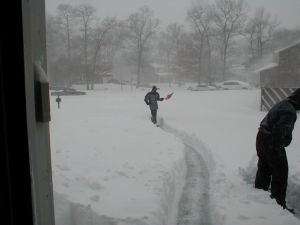
Winter is harsh and cold weather moving can make a difficult job even worse, especially if you are moving. Between the snow and freezing temperatures, home owners have to find the best way move without causing too much stress. While hiring a professional moving company like Men on the Move can help, there are few things you should know to help your winter move along.

On moving day, you need to remember you hired a moving company on moving day not a snow removal company. Moving companies will not clear the snow for your move. So, before they arrive, people need clear the driveway, walkway, sidewalks, back decks, and basement walkouts. Leaving snow and ice covering these areas are potential hazards that can injure the movers or others. That is why it’s important the pathways a clear for the moving process.
For a homeowner, there are few things you need to prepare for the movers. First of all, you need to make sure you have a friend or family member playing doorman for the movers. You wouldn’t want a moving technician carrying your expensive flat screen TV while trying to open a door. If you aren’t against a little cold, you could also keep the front door open.
Protecting your floors and carpet from winter sludge and mud should be a priority. Typically for an additional fee, the moving company will lay plastic carpet protector along the main walkways of the home before the moving begins. There are logistical, liability, and safety concerns associated with movers wearing any type of disposable shoe covers. Check with your moving company before the scheduled moving day.
Another thing you should keep on an eye on is your electronics. Extreme temperature changes can cause condensation build up on the high tech circuits. Consumer electronic items such as computers, laptops, DVD players, TVs, stereos are subject to this. It is best for your electronics to acclimate to room temperature for at least 24 hours before plugging everything in and setting it up.
If you are moving appliances into your home, you need to make sure it ready.
Washers
Even though your washer should be drained before moving it, the washer will always maintain a little water. Components like the mixer valve, pump housing and internal hose areas may have moisture. Using your washer while water is frozen in these components can result in damage to belts, hoses and other internal parts of the washer. Your washer should only be operated at a temperature of above 60°F.
Dryers
Like most things when subject to freezing temperatures, igniters and heating elements in the dryer can become brittle. Operating the dryer will cause a sudden temperature change and may damage internal parts. Your dryer should only be operated at a temperature of above 60°F.
Refrigerators
A refrigerator may be plugged in for use the day of the move, but the ice maker should not be connected to the water supply for at least 24 hours. Moisture in the solenoid valve, supply lines and cold-water reservoir may be frozen. This will hinder the normal operation of the icemaker. If the cold water reservoir was not drained before the move started, it could be frozen solid causing hairline cracks in the water reservoir. It is very important to let all components of the ice maker system reach operating temperature first. Then a thorough check can be completed after hooking up the water supply.
Open doors and lower thermostat settings are typical moving day phenomenon. So remember to think of your pets and indoor plants as well when moving in winter.

Let’s face it, winter moving is not fun. In addition to all the stressors that come with moving, you also have to deal with seasonal hazards. Fortunately, you can avoid all of these issues by hiring professional movers at Men on the Move! However, what hazards will you be facing during the snowy season?
The winter season brings a list of hazards that are hard to overcome alone. These three months bring snow and ice, which leads to horrible moving conditions. In addition to the slipping hazards, dirt mixes into the snow leading to a disgusting mess behind you. Slush is the natural enemy of your floors, bringing in dirt and salt stains.
There are also issues that come with packing up your garage or shed. If your garage is attached, you might have fewer issues with the slush and dirt at first. However, that advantage goes out the window with a detached garage or shed. You will have to trudge directly outside to get any packing done.
Winter moving is uncomfortable. Even with helpful cold weather moving tips, moving or relocating is hard. Well, there is a way to make moving this season easier!
During these weather conditions, professional moves can do much of the work for you in the nasty weather. In fact, Men on the Move during the winter you might want to take advantage of Men on the Move’s professional packing services! Home, garage, basement or shed, we pack & move your belongings making winter moving feel like a warm summer breeze!
Since 1991, our professional staff has been moving households to their new homes. Whether you are moving locally or long-distance, Men on the Move can help you. We are regularly offering moving specials to help you during one of the most stressful times of the year. One of these specials is our current Mid-Week Moving Winter Special!
Stay warm this winter by allowing Men on the Move to move you! Also, keep up with our regular specials by signing up for our mailing list.